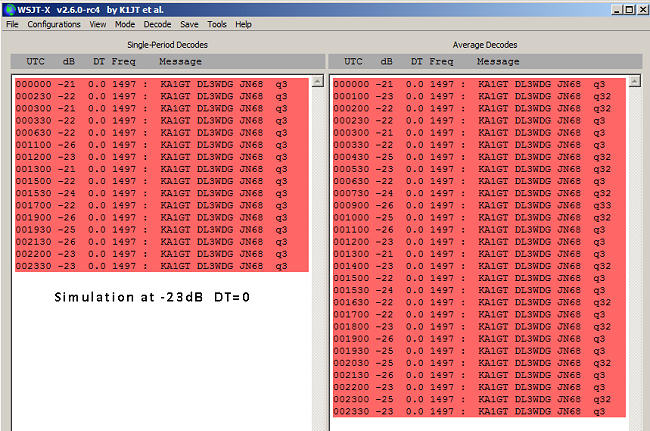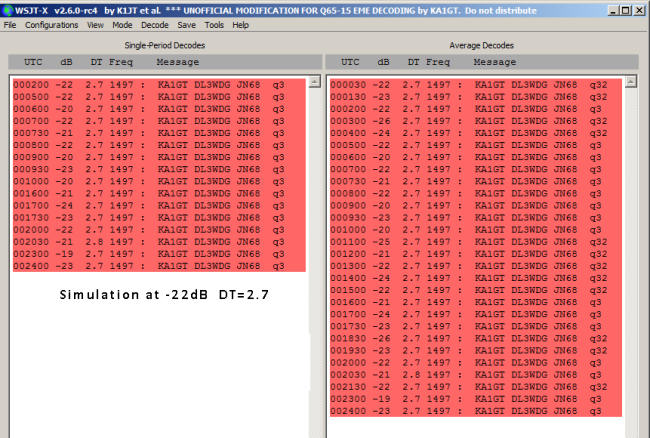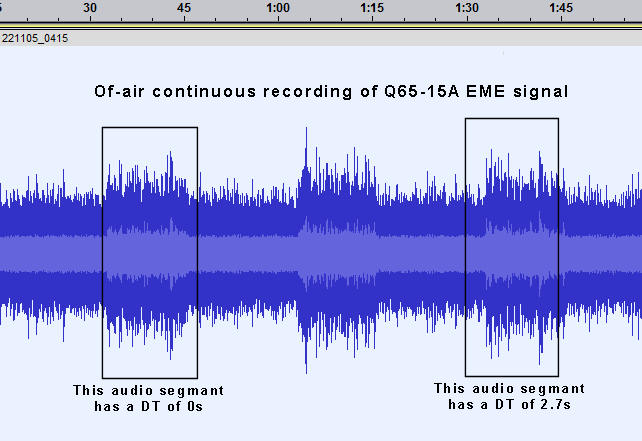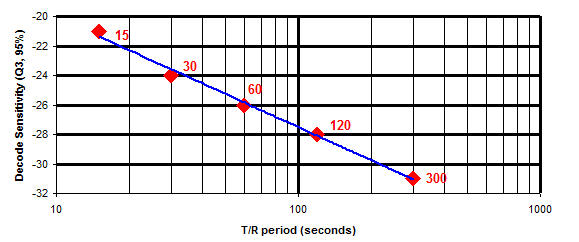Q65-15A Part II Testing and Sensitivity

This is a further report on testing the Q65-15A mode on EME. The issues involved are fully describes here Q65-15 issues on EME. This backs up the conclusions reached there with additional information.
Simulation studies
EME signals can be well simulated using tools such as Q65sim.exe which are part of the WSJTX package. In this test I created two sets of files. The first is at a nominal SNR of -23dB (in a 2500Hz bandwidth) and has a DT of 0s. This is representative of a signal with no delay which can be properly decoded by WSJTX when the "Decode after EME delay" box is NOT checked. In this case the full message is available for decoding. Here is a screen shot of the results of decoding 50 files. Each file will different due the the statistics of noise and libration fading. This accurately simulates EME signals.

So at -23dB you can see 16 single period Q3 decodes and 12 two-period average decode, making a total of 28 decodes in all, a decode rate of 56%. This represents what can be regarded as the "decode threshold" for a Q3 decode of a Q65-15A signal at -23dB. There are four single period decodes at an indicated -25/-26dB and five more for two-period decodes. The average single period decode strength is -23dB.
The second set of simulations was made at -22dB and with a DT of 2.7s, typical of an EME echo. As explained in the earlier referenced article, there is some truncation of the message due to the EME delay and the 15s period. This results in some loss of decode sensitivity. The official version of WSJTX (2.6.0) will not decode these dignals, but I made some small modification to the source code which allows decoding (with some limitations, like the "Single Decode" box must be checked). This simulation is 1dB stronger than the simulation for DT=0. Here is a screen-shot of decode results:

Coincidentally, the decode results mirror those of the DT=0 decodes, but at a 1dB higher SNR. There are again 16 single period decodes and 12 two-period average decodes for a total of 28 decodes and a 56% decode success. So in this case the decode threshold might be considered to be around -22dB. The lowest indicated SNR for a single period decode is -24dB in this case and there are two -26/-25 two-period decodes. The fact that the number of decodes is the same is a coincidence. The DT=0 signal shows more decodes at an indicated -25/-26dB level. The average single period decode strength was -22dB. Some other test using other techniques show slightly different numbers, but the general conclusion from all the tests is that Decoding of EME Q65-15 signals results in about a 1dB sensitivity loss compared with signals that have no EME delay. This is due to the end of the message being truncated due to timing constraints.
Other tests and test methods
I have run multiple tests with the help of Bill, KB2SA and others. We have made direct QSOs using my modified version of WSJTX. It's also possible to run tests with stations who only have the standard version of WSJTX. They can send Q65-15A perfectly well and with the modified code, I can decode it. I can also send Q65-15A with my clock set 2.5 seconds fast. A station receiving my Q65-15A signal can then decode it perfectly well if the UNcheck "Decode after EME delay". You can't easily make a QSO this way but it's fine for one way tests. Again with these tests it looks like the EME delay and message truncation costs about 1dB in sensitivity and that Q65-15A is a very viable mode for EME communication on 1296, even with a truncated messages.

Another technique for comparing decoding was to have Bill send a series of messages which I recorded as one continuous audio file. I could then cut up that file so that I had messages with no delay (DT=0) and messages that had a normal delay (DT=2.7). The DT=0 messages had about 0.5s or noise preceding the start of the tones, the DT=2.7 had about 3.2s of noise preceding the start of the tones. Again the DT=0 messages seemed to have about a 1dB decoding advantage.
Sensitivity estimates and equipment required for Q65-15A on 1296
The relative sensitivity of the various modes and submodes of Q65 (based on 1296 simulations and on air tests) is as follows.

The 15s period sensitivity is for the current, truncated data implementation.
For the purposes of this analysis I'm going at assume a non-optimized EME station with just 100W at the dish feed. I'm assuming a septum feed, but without any choke enhancement and a receive system with an overall noise figure of 0.4dB. A well optimized station would have several dB more sensitivity than this. I'm also assuming the moon is midway between apogee and perigee, so the Dgrd is around 1.2dB.
Decode threshold for a high probability of a single period decode (Q3) is around -21dB for Q65-15A. Using EMECalc to estimate system performance I get the following SNR leves:
- 2m dish to 2m dish -20.5dB
- 1.5m dish to 2.4m dish -21.4dB
- 2m dish to 2.4m dish -19dB
- 2m dish to 3m dish -17dB
- 1.2m dish to 4m dish -19dB
- 3m dish to 3m dish -13.5dB
And from on air testing, Q65-15A signals have been decoded between a 1.9m dish and a 3m dish, with both stations running around 25W. Also a 1.2m dish has received and decoded Q65-15A signals from a 3.1m dish running 240W.
Remember, these numbers are for 100W at each end of the link, which is probably 3 to 6dB less than most stations are Currently using. They are also for stations not running the best feeds or lowest noise figure receivers. All of these systems should be quite capable of making Q65-15A QSOs, even with a truncated message packet. Q65-15 would not be a good mode for anyone running a Yagi antennas (low gain and 3dB polarization loss), and/or very low power, and/or a system which was far from optimized, and/or a system with poor moon tracking ability.
Previously, I've looked at FT8, also a 15s mode, for EME and found it usable, even though it suffers from data truncation due to the short period and EME delay (just like Q65-15A). However, as mentioned in my previous article on Q65-15A, during a one way tests to Charlie, DL3WDG, we compared decoding of Q65-15A signals with FT8 signals. Both have a 15s Tx/Rx period. Charlie was unable to decode any of the FT8 transmissions, but had no trouble with the Q65-15A transmission, further evidence of the robustness of the Q65 encoding. So although FT8 works, Q65-15A works much better.
How could Q65-15 be modified to work better?
To avoid truncating the message, the message packet would need to be shortened from around 12.8s to around 10s. This could be done by shortening each tone length from 0.15s (as it currently is) to around 0.12s. That would produce a message packet length of 10.2s. Of course a shorter message symbol length will itself lead to a small loss in decode sensitivity. That's why Q65-30B(25.5s message packet) is less sensitive than Q65-60C (51s message packet) and Q65-120D (113.3s message packet) is more sensitive then Q65-60C. However the change from a 12.8s package to a 10.2s packet would only result in a small sensitivity loss. Probably less than 1dB. The shorter package may not have much advantage over the truncated package in terms of sensitivity, but it is a "cleaner" way to do this, would make decoding easier and probably enable deep decoding and the decoding of multiple signals rather than just a single signal. Actually changing the packet length for Q65-15 when "Decode after EME delay" is checked is beyond my capabilities, but in principle it could certainly be done, at least as an experiment. Whether anyone tries it is not up to me!
Whether a Q65-15A mode would be used on 1296 (or other bands) is another question. Some contest and Dxpedition stations have expressed an interest. It's also just intrinsically interesting to have another mode available to "play" with, especially one which allows 1 minute QSOs. This probably makes it faster (and certainly more sensitive) than CW for the vast majority of stations. I can't work EME CW with 15 second overs, and I certainly can't work CW at all at -20dB SNR. The fact that Q65-30B is so little used when it's a very effective protocol (even for fairly small stations), suggests that Q65-15A may not be widely used, at least not without a lot mode user education.
Q65-15 does not exclude small stations either. In testing with Bill, KB2SA, we found that we could complete a QSO with each of us running about 25W at the dish feed. Bill was using a 1.9m dish, I was running a 3.1m dish. This suggests that Q65-15A contacts on 1296 would be relatively easy between two well optimized stations with 2m dishes running only 100W. It certainly would not be the default mode for use on 1296, and real QRP stations (single Yagi and 100-200W) would need 30B or 60C (or even 120D) to work the average 1296 stations (which I'm guessing is something like a 3m dish and 300W these days).
The future of Q65-15A
I have no idea what will happen with Q65-15A EME in the future. I will be experimenting with it, and modifying WSJTX to enable its use while I can, but it would only become part of WSJTX if the development team decide that it's worth to effort to do that. If you have any questions or comments, you are welcome to contact me via email - [my callsign]@hotmail.com
.jpg)